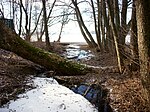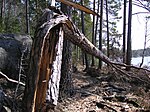Skärholmen metro station
Railway stations in Sweden opened in the 1960sRailway stations opened in 1967Red line (Stockholm metro) stationsStockholm Metro stubsSwedish railway station stubs

Skärholmen metro station is a station on the red line of the Stockholm metro, located in the district of Skärholmen. The station was opened on 1 March 1967 as the south terminus of an extension from Sätra. The distance to Slussen is 11.7 km (7.3 mi). Skärholmen is the closest metro station to the Kungens Kurva area and its adjacent retail park. It is also expected to become an interchange station with the future Spårväg syd light rail line from 2031.
Excerpt from the Wikipedia article Skärholmen metro station (License: CC BY-SA 3.0, Authors, Images).Skärholmen metro station
Äspholmsvägen, Stockholm Skärholmen (Skärholmens stadsdelsområde)
Geographical coordinates (GPS) Address Nearby Places Show on map
Geographical coordinates (GPS)
| Latitude | Longitude |
|---|---|
| N 59.277119 ° | E 17.907003 ° |
Address
Äspholmsvägen
Äspholmsvägen
127 48 Stockholm, Skärholmen (Skärholmens stadsdelsområde)
Sweden
Open on Google Maps











